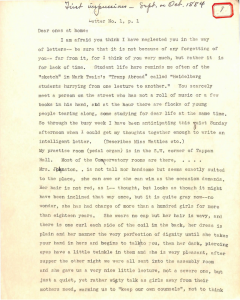Authors: Frances Densmore
Recipients: “Ones at home”
Dates: Fall 1884
Location: Frances Theresa Densmore Letters 1884-86, Letter No. 1, Record Group 30/156, O. C. A.
Document Type: Typed Letter Copy
Introduction:
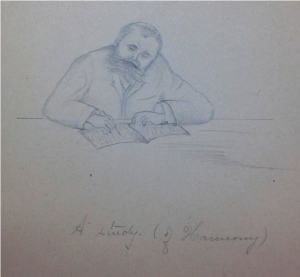 The letter is addressed broadly to “ones at home” which were most likely Densmore’s family and close friends. This emphasis on distance situates Densmore as a woman traveler; she “did not have to wait at home while men had the prerogative to journey out and return to tell the stories.”1 In the letter, Densmore wrote about the busyness of school life and gave specific visual observations about the campus and people she met. Her writings purposefully captured her daily life in a way that her family and friends could visualize. Especially notable are her first experiences with people of another race, as well as her commitment to following the college’s rules and maintaining a good character. Densmore vividly expressed her personality, whether it was through the fun and silly way she described her interactions with boys at the college or the awe she expressed towards the political climate of Oberlin. The reader can truly catch a glimpse of Densmore’s world and the woman she would become.
The letter is addressed broadly to “ones at home” which were most likely Densmore’s family and close friends. This emphasis on distance situates Densmore as a woman traveler; she “did not have to wait at home while men had the prerogative to journey out and return to tell the stories.”1 In the letter, Densmore wrote about the busyness of school life and gave specific visual observations about the campus and people she met. Her writings purposefully captured her daily life in a way that her family and friends could visualize. Especially notable are her first experiences with people of another race, as well as her commitment to following the college’s rules and maintaining a good character. Densmore vividly expressed her personality, whether it was through the fun and silly way she described her interactions with boys at the college or the awe she expressed towards the political climate of Oberlin. The reader can truly catch a glimpse of Densmore’s world and the woman she would become.
Transcription:
<First impressions – Sept. or Oct. 1884>
I am afraid you think I have neglected you in the way of letters– be sure that it is not because of any forgetting of you– far from it, for I think of you very much, but rather it is for lack of time. Student life here reminds me often of the “sketch” in Mark Twain’s “Tramp Abroad” called “Heidelberg students hurrying from one lecture to another.”2 You scarcely
meet a person on the street who has not a roll of music or a few books in his hand, al<n>d at the hour there are flocks of young people tearing along, some studying for dear life at the same time.
So through the busy week I have b<e>en anticipating this w<q>uiet Sunday afternoon when I could get my thoughts together enough to write an intelligent letter. (Describes Miss Wattles etc.)3 My practise room (pedal organ) is in the S. W. corner of Tappan Hall.4 Most of the Com<n>servatory rooms are there, …. Mrs. Jlb<oh>nston5 is not tall nor handsome but seems exactly suited to the place, she can awe or she can win as the occasion demands. Her hair is not red, as L–6 thought, but looks as though it might have been inclined that way once, but it is quite gray now–no wonder, she has had charge of more than a hundred girls for more than eighteen years.  She wears no cap but her hair is wavy, and there is one curl each side of the coil in the back, her dress is plain and her manner the very perfection of dignity until she takes your hand in hers and begins to talkto [sic] you, and her dark, piercing eyes have a little twinkle in them and she is very pleasant, after supper the other night we were all sent into the assembly room and she gave us a very nice little lecture, not a severe one, but just a quiet, yet rather wittty [sic] talk as girls away from their mothers need, warning us to “keep our own counsels”,7 [sic] not to think “he was a love of a fellow, for we might discover that he was a miserable coot,”8 not to make too many intimate friends at first, she had known girls “who make five fast friends in three days,” in short, not only explaining the rules and regulations but giving sundry hints and explanations as to what make up a girl<’>s good character when she is away at school….. The bell-boy, like the porter, is a mulatto but the girls say the man who makes the bread is a genuine nig: the first person I saw when I got off from the train was a funny little black boy and I have seen plenty of them since. Some of the girls here at the Hall are colored, it seems queer enough to me to see these quaint figures I have read about so much, there is one who seems to hold his post at the hotel corner, a very tall, rather old darkey with a batter silk plug hat,9 a long white (?) [sic] linen ulster10 and a cane, just true to the descriptions. I am going to send you room-mate(s [sic] picture etc.11 We are being just as good as we can, have not been late to breakfast nor prayers at Chapel and not have spoken aloud after seven-thirty and have put out the light by ten, in short we have been doing our best not to break a rule and so far have no failures to report.12
She wears no cap but her hair is wavy, and there is one curl each side of the coil in the back, her dress is plain and her manner the very perfection of dignity until she takes your hand in hers and begins to talkto [sic] you, and her dark, piercing eyes have a little twinkle in them and she is very pleasant, after supper the other night we were all sent into the assembly room and she gave us a very nice little lecture, not a severe one, but just a quiet, yet rather wittty [sic] talk as girls away from their mothers need, warning us to “keep our own counsels”,7 [sic] not to think “he was a love of a fellow, for we might discover that he was a miserable coot,”8 not to make too many intimate friends at first, she had known girls “who make five fast friends in three days,” in short, not only explaining the rules and regulations but giving sundry hints and explanations as to what make up a girl<’>s good character when she is away at school….. The bell-boy, like the porter, is a mulatto but the girls say the man who makes the bread is a genuine nig: the first person I saw when I got off from the train was a funny little black boy and I have seen plenty of them since. Some of the girls here at the Hall are colored, it seems queer enough to me to see these quaint figures I have read about so much, there is one who seems to hold his post at the hotel corner, a very tall, rather old darkey with a batter silk plug hat,9 a long white (?) [sic] linen ulster10 and a cane, just true to the descriptions. I am going to send you room-mate(s [sic] picture etc.11 We are being just as good as we can, have not been late to breakfast nor prayers at Chapel and not have spoken aloud after seven-thirty and have put out the light by ten, in short we have been doing our best not to break a rule and so far have no failures to report.12
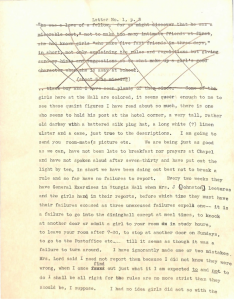 Every two weeks they have General Exercises13 in Sturgis Hall14 when Mrs. J <[>Johnston<]> lectures and the girls hand in their reports, before which time they must have their failures excused as three unexcused failures expells one—it is a failure to go into the dininghall except meal times, to knock at another door or admit a girl to your room dm in study hours, to leave your room after 7-30, to stop at another door on Sundays, to go to the Postoffice etc.(pen mark) till it seems as though it was a failure to turn around.I have ignorantly made one or two mistakes. Mrs. Lord15 said I need not report them because I did not know they were wrong, when I once found find out just what it I am expected to and not to do I shall be all right for the rules are no more strict than they should be, I suppose. I had no idea girls did act so with the young gents until I saw a Miss—carry on. I don’t wonder they have to lay down the law hard. The girls at our table are real nice but the gentlemen! The one who sits next to me is as much like— as two persons can be in looks, talk and manners, and I am convinced that he must write poetry. I shall have no more to do with him than necessary. The others are great, tall spooky fellows. Before the <t>ables were permanently arranged we had four nice little boys, two of whom never but once spoke a word, however, they were good looking and I wish we had kept them <t>o look at, one of the others had been hit in one eye with a baseball and it took most all <of> the other to se<e> to eat, so he didn’t bother us, and the other boy was a Conservatory student and asked me regularly, three times a day, “Allow me—Miss
Every two weeks they have General Exercises13 in Sturgis Hall14 when Mrs. J <[>Johnston<]> lectures and the girls hand in their reports, before which time they must have their failures excused as three unexcused failures expells one—it is a failure to go into the dininghall except meal times, to knock at another door or admit a girl to your room dm in study hours, to leave your room after 7-30, to stop at another door on Sundays, to go to the Postoffice etc.(pen mark) till it seems as though it was a failure to turn around.I have ignorantly made one or two mistakes. Mrs. Lord15 said I need not report them because I did not know they were wrong, when I once found find out just what it I am expected to and not to do I shall be all right for the rules are no more strict than they should be, I suppose. I had no idea girls did act so with the young gents until I saw a Miss—carry on. I don’t wonder they have to lay down the law hard. The girls at our table are real nice but the gentlemen! The one who sits next to me is as much like— as two persons can be in looks, talk and manners, and I am convinced that he must write poetry. I shall have no more to do with him than necessary. The others are great, tall spooky fellows. Before the <t>ables were permanently arranged we had four nice little boys, two of whom never but once spoke a word, however, they were good looking and I wish we had kept them <t>o look at, one of the others had been hit in one eye with a baseball and it took most all <of> the other to se<e> to eat, so he didn’t bother us, and the other boy was a Conservatory student and asked me regularly, three times a day, “Allow me—Miss 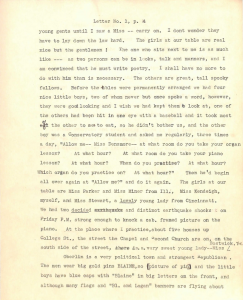 Densmore—at what room do you take your organ lesson? At what hour? At what room do you take your piano lesson? At what hour? When do you practise? At what hour? Which organ do you practice on? At what hour?” Then he’d begin all over again at “Allow me?” and do it again. The girls at our table are Miss Parker16 and Miss Miner from Ill.,17 Miss Kendeigh,18 myself, and Miss Stewart,19 a lovely young lady from Cincinnati. We had two decided earthquake and distinct earthquake shocks on Friday P.M. strong enough to knock a cab.20 framed picture on the piano. At the place where I practice, about five houses up College St., the street the Chapel and Second Church are on, on the south side of the street, .the.re .is. a. [sic] very sweet young lady—Miss^ Bostwick. (fe) [sic]21
Densmore—at what room do you take your organ lesson? At what hour? At what room do you take your piano lesson? At what hour? When do you practise? At what hour? Which organ do you practice on? At what hour?” Then he’d begin all over again at “Allow me?” and do it again. The girls at our table are Miss Parker16 and Miss Miner from Ill.,17 Miss Kendeigh,18 myself, and Miss Stewart,19 a lovely young lady from Cincinnati. We had two decided earthquake and distinct earthquake shocks on Friday P.M. strong enough to knock a cab.20 framed picture on the piano. At the place where I practice, about five houses up College St., the street the Chapel and Second Church are on, on the south side of the street, .the.re .is. a. [sic] very sweet young lady—Miss^ Bostwick. (fe) [sic]21
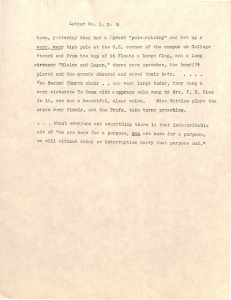 Oberlin is a very political town and strongest Republican. The men wear big gold pins BLAINE, so <[>picture of pin<]> and the little boys have blue caps with “Blaine” in big letters on the front, and although many flags and “Bl. and Logan” banners are flying about town, yesterday they had a (b)grand “pole-raising” and set up a very, very high pole at the S. E. corner of the campus on College Street and from the top of it floats a large flag, and a long streamer “Blaine and Logan,” there were speeches, the band (?) [sic] played and the crowds cheered and waved their hats…..22 The Second Church choir… was very large today, they sang a very elaborate Te Deum23 with a soprano solo sung by Mrs. F. B. Rice24 in it, she has a beautiful, clear voice. Miss Wattles plays the organ very finely, and the Profs. Take turns preaching.
Oberlin is a very political town and strongest Republican. The men wear big gold pins BLAINE, so <[>picture of pin<]> and the little boys have blue caps with “Blaine” in big letters on the front, and although many flags and “Bl. and Logan” banners are flying about town, yesterday they had a (b)grand “pole-raising” and set up a very, very high pole at the S. E. corner of the campus on College Street and from the top of it floats a large flag, and a long streamer “Blaine and Logan,” there were speeches, the band (?) [sic] played and the crowds cheered and waved their hats…..22 The Second Church choir… was very large today, they sang a very elaborate Te Deum23 with a soprano solo sung by Mrs. F. B. Rice24 in it, she has a beautiful, clear voice. Miss Wattles plays the organ very finely, and the Profs. Take turns preaching.
… About everyone and everything there is that indescribable air of “we are here for a purpose, you are here for a purpose, we will without delay or interruption carry that purpose out.”
Transcribed by Camille Pass and Kristin McFadden
1 Joan M. Jensen and Michelle Wick Patterson, eds., Travels with Frances Densmore: Her Life, Work, and Legacy in Native American Studies (Lincoln ; London: University of Nebraska Press, 2015), 5.
2 A Tramp Abroad (1880) is a novel written by Mark Twain about his travels with his friend Joseph Twichell in the Black Forest and the Swiss Alps (Encyclopedia Britannica Online, s. v. “Mark Twain”, Web address, accessed 4 May 2015).
3 Lucretia Celestia Wattles (1849-1933), professor of pianoforte (piano) and harmony at Oberlin Conservatory from 1871 to 1892. “Noted as a woman of wisdom and high standards, she was credited, along with Fenelon B. Rice, with building the strong foundations of today’s piano department.” The note in parenthesis was written by Densmore to show there was more written about Mrs. Wattles, but she omitted the section from her transcription because she was unable to read her own handwriting (Wattles Family Papers 1860-1953, Record Group 30/273, O. C. A.).
4 Tappan Hall was built in the center of campus in 1836 after Mr. Arthur Tappan donated $10,000 for its construction. The first floor held four practice rooms, and the upper floors served as a boys-only dormitory. The building was torn down in 1885 (Illustrated Building Guide, 10. Tappan Hall, O. C. A.).
5 Adelia A. Field Johnston (1837-1910), Principal of the Women’s Department from 1870-1900, and professor of Late Medieval History from 1870-1907. She was the first woman to receive full membership from the Oberlin faculty. In addition, Johnston helped raise most of the money for major buildings in Oberlin, and led the Oberlin Village Improvement Society. See the mini-edition “Singular Charm and Superb Character”- The Life of Adelia Antoinette Field Johnston for more information.
6 “L–” could be a reference to a name, perhaps Louisa Parker, who she mentions as a close friend in Letter No. 34.
7 This is not a new rule of Johnston’s. She writes on 27 October 1871 in her notebook, “Careful what you tell gentlemen, how many secrets you confide to them” (Adelia A. Field Johnston Papers, Series IV. Writings and Notebooks, 1862-1994, Record Group 30/19, O. C. A.).
8 A silly person, simpleton.
9 A man’s tall silk hat, a top hat.
10 A long loose overcoat of Irish origin made of heavy material, frequently with a waist-belt.
11 Densmore made significant typos while trying to write “send you my roommate’s picture,” and wrote “etc.” to indicate she expanded on this subject, but wasn’t able to read her handwriting.
12 See Reference Document 1 for Dean of Women’s Adelia Field Johnston’s list of rules.
13 In Singular Charm and Superb Character”- The Life of Adelia Antoinette Field Johnston, Rebecca Debus writes, “The General Exercises were lectures given by Johnston (as the Dean of Women) every two weeks to the female student body. These lectures covered a variety of subjects, and were intended to aid the young women as they prepared to enter the wider world, either as wives, mothers, or professionals in their own right. Many of her former students remembered these lectures vividly and they seem to have made a great impression on the whole of the female student body” (Harriet Louise Keeler, The Life of Adelia A. Field Johnston Who Served Oberlin College for Thirty-Seven Years … Britton Printing Company, 1912).
14 Sturges Hall (1884-1963) was named for Susan M. Sturges and built from 1883 to 1884 (Illustrated Building Guide, 24. Sturges Hall, O. C. A.).
15 Mrs. Elizabeth R. Lord (1839-1900) was appointed as the assistant Principal of the Ladies’ Department in 1884 and was a friend of Adelia A. Field Johnston. She was passionate about education and missionary life. See Document 5 for more on Lord and Johnston (“Mrs. Elizabeth R. Lord and Lord Cottage” Oberlin Art Library, Web address, accessed 7 May 2015).
16 Louisa Woodward Parker, who enrolled in the conservatory from 1884 to 1886, and was from Winchester, Illinois.
17 Bertha (Bertie) Hawthorne Miner, enrolled in the conservatory from 1884 to 1887. Densmore boarded in Mrs. Reamer’s house in 1885, and in a diagram of it she notes that she lived with Bertha and her sister Luella. See Women “Rule the World:” The Lives and Impact of Female Missionaries for more on Luella Miner.
18 Probably Jennie Lynn Kendeigh (Mrs. Marston S. Freeman) who enrolled in the preparatory and conservatory from 1883 to 1885, and the literary course and conservatory from 1885 to 1889. Kendeigh was from South Amherst, Ohio.
19 Louise Sumner Stewart (Mrs. Henry H. Baker) enrolled in the Literary Course from 1884 to 1889.
20 Densmore abbreviates the word Cab. to mean Cabinet, in reference to the Cabinet Card photograph. Cabinet Card photography was a popular form of portraiture in the 1860s and 1870s and a beloved fixture in Victorian parlor rooms (“Cabinet Card” City Gallery, Web address, accessed 7 May 2015).
21 Possibly Lila Aminta Bostwick, who enrolled in the conservatory from 1883 to 1885.
22 In 1884, James G. Blaine, a Republican senator, ran for President against Democrat Grover Cleveland, Governor of New York. Blaine’s vice presidential candidate was named John Logan. He lost to Cleveland, who went on to hold office for two terms from 1885 to 1897 (“1884 Cleveland v. Blaine” Harp Week: Explore History, Web address, accessed 7 May 2015; “Presidential Election of 1884: A Resource Guide” The Library of Congress, Web address, accessed 7 May 2015).
23 Densmore references the Second Church choir singing the Christian hymn of praise, Te Deum. The hymn itself is in Latin and translates to,“Thee, O God, we praise” (“The Te Deum,” New Advent, Web address, accessed 7 May 2015).
24 Helen Maria Rice was a vocal teacher from 1869 to 1873, and served on the Women’s Board of Managers (a group which supervised women students at Oberlin) from 1876 to 1901. She was the wife of Fenlon B. Rice, Director of the Conservatory from 1871 to 1901 (Oberlin College, General Catalogue of Oberlin College 1833-1908 (Oberlin: Oberlin College, 1909), 811).
